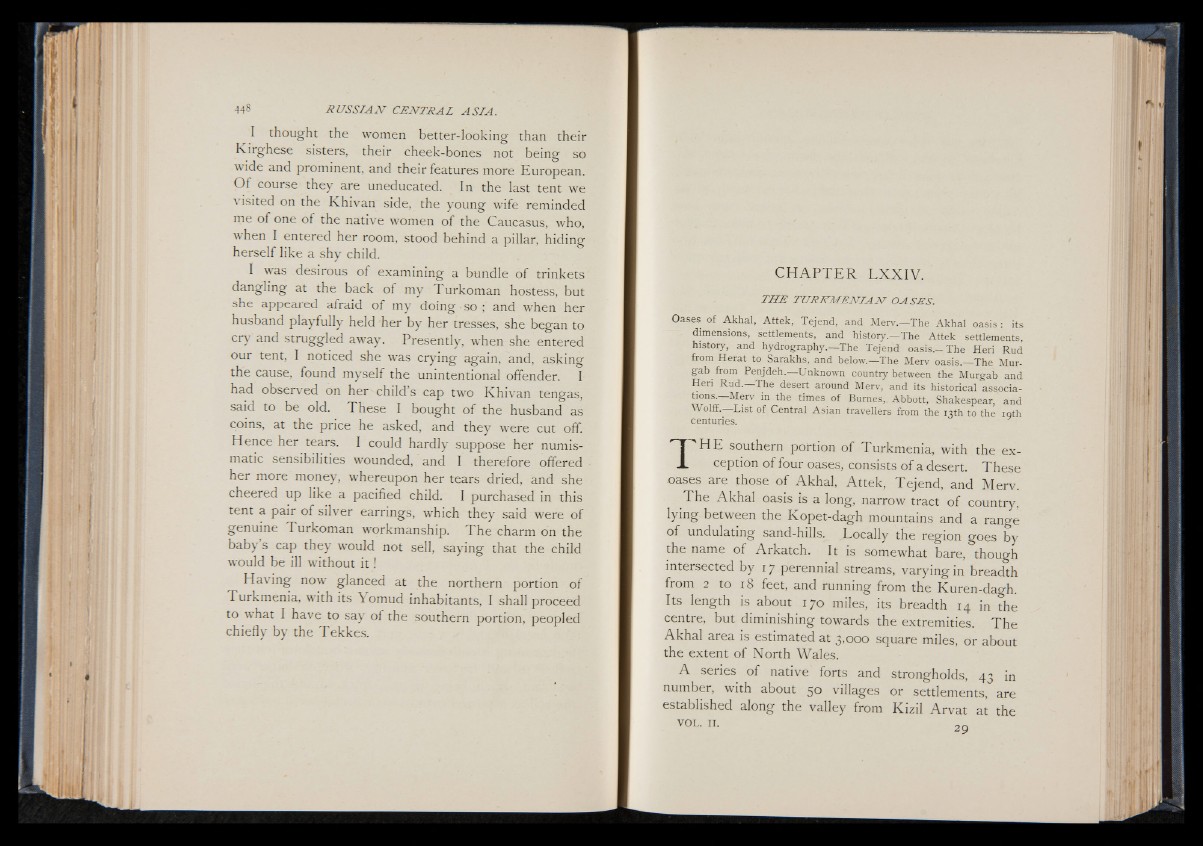
I thought the women better-looking than their
Kirghese sisters, their cheek-bones not being so
wide and prominent, and their features more European.
O f course they are uneducated. In the last tent we
visited on the Khivan side, the young wife reminded
me o f one o f the native women of the Caucasus, who,
when I entered her room, stood behind a pillar, hiding
herself like a shy child.
I was desirous o f examining a bundle of trinkets
dangling at the back o f my Turkoman hostess, but
she appeared afraid o f my doing • so ; and when her
husband playfully held her by her tresses, she began to
cry and struggled away. Presently, when she entered
our tent, I noticed she was crying again, and, asking
the cause, found myself the unintentional offender. I
had observed on her child s cap two Khivan tengas,
said to be old. These I bought of the husband as
coins, at the price he asked, and they were cut off.
Hence her tears. I could hardly suppose her numismatic
sensibilities wounded, and I therefore offered
her more money, whereupon her tears dried, and she
cheered up like a pacified child. I purchased in this
tent a pair o f silver earrings, which they said were of
genuine Turkoman workmanship. T h e charm on the
baby s cap they would not sell, saying that the child
would be ill without i t !
Having now glanced at the northern portion of
Turkmenia, with its Yomud inhabitants, I shall proceed
to what I have to say o f the southern portion, peopled
chiefly by the Tekkes.
C H A P T E R L X X IV .
T H E T U R K M E N I A N O A S E S .
Oases of Akhal, Attek, Tejend, and Merv.— The Akhal oasis : its
dimensions, settlements, and histoiy.— The Attek settlements,
history, and hydrography.— The Tejend o a s is .-T h e Heri Rud
from Herat to Sarakhs, and below.— The Merv oasis.— The Mur-
gab from Penjdeh.— Unknown country between the Murgab and
Hen Rud.— The desert around Merv, and its historical associations.—
Merv in the times of Bumes,. Abbott, Shakespear, and
Wolff.— List of Central Asian travellers from the 13th to the 10th
centuries.
P 'H E southern portion of Turkmenia, with the ex-
X ception of four oases, consists of a desert. These
oases are those o f Akhal, Attek, Tejend, and Merv.
T he Akhal oasis is a long, narrow tract o f country,
lying between the Kopet-dagh mountains and a range
o f undulating sand-hills. Locally the region goes by
the name o f Arkatch. It is somewhat bare, though
intersected by 17 perennial streams, varying in breadth
from 2 to 18 feet, and running from the Kuren-dagh.
Its length is about 170 miles, its breadth 14 in the
centre, but diminishing towards the extremities. The
Akhal area is estimated at 3,000 square miles, or about
the extent of North Wales.
A series of native forts and strongholds, 43 in
number, with about 50 villages or settlements, are
established along the valley from Kizil Arvat at the
VOL. II. 2p